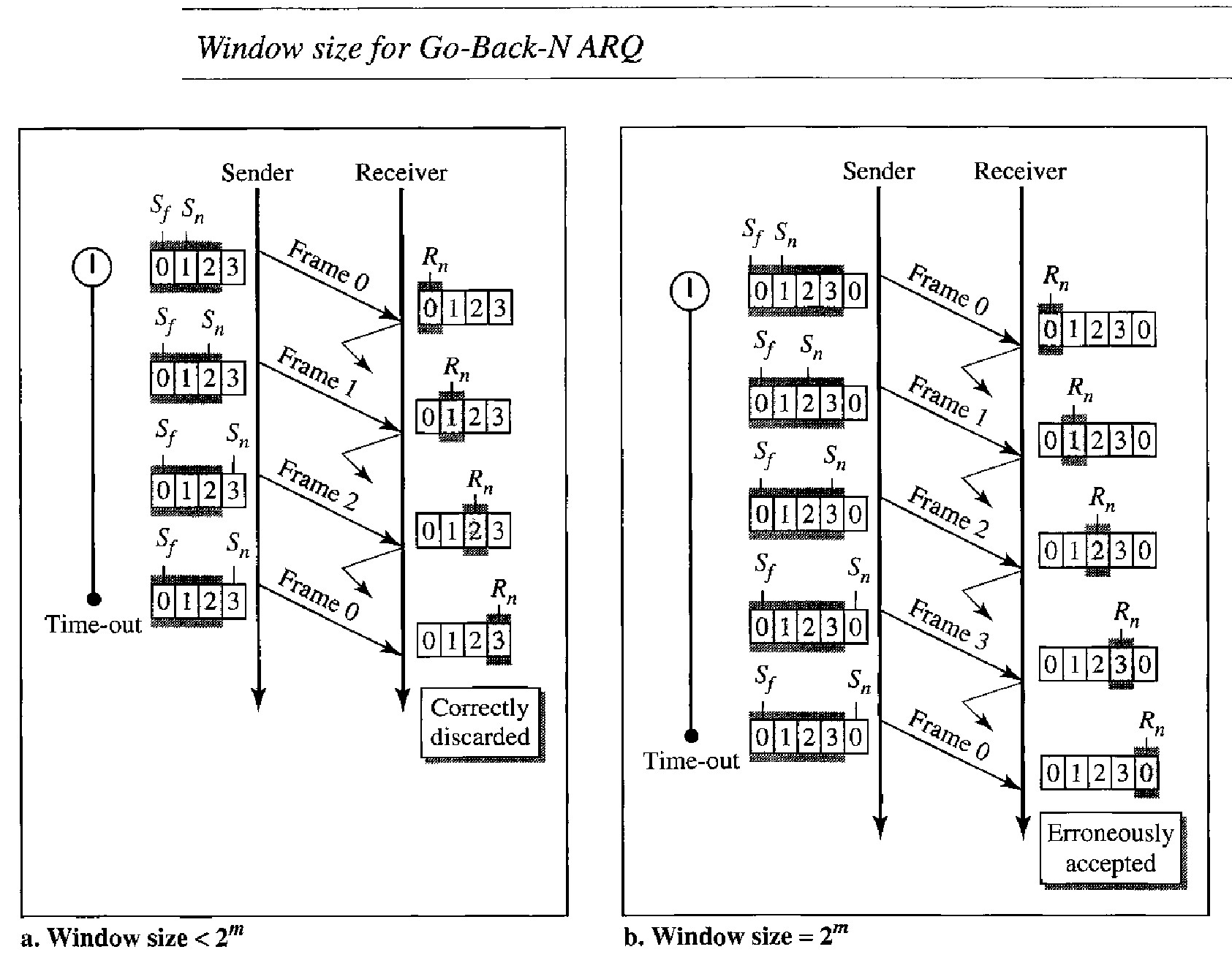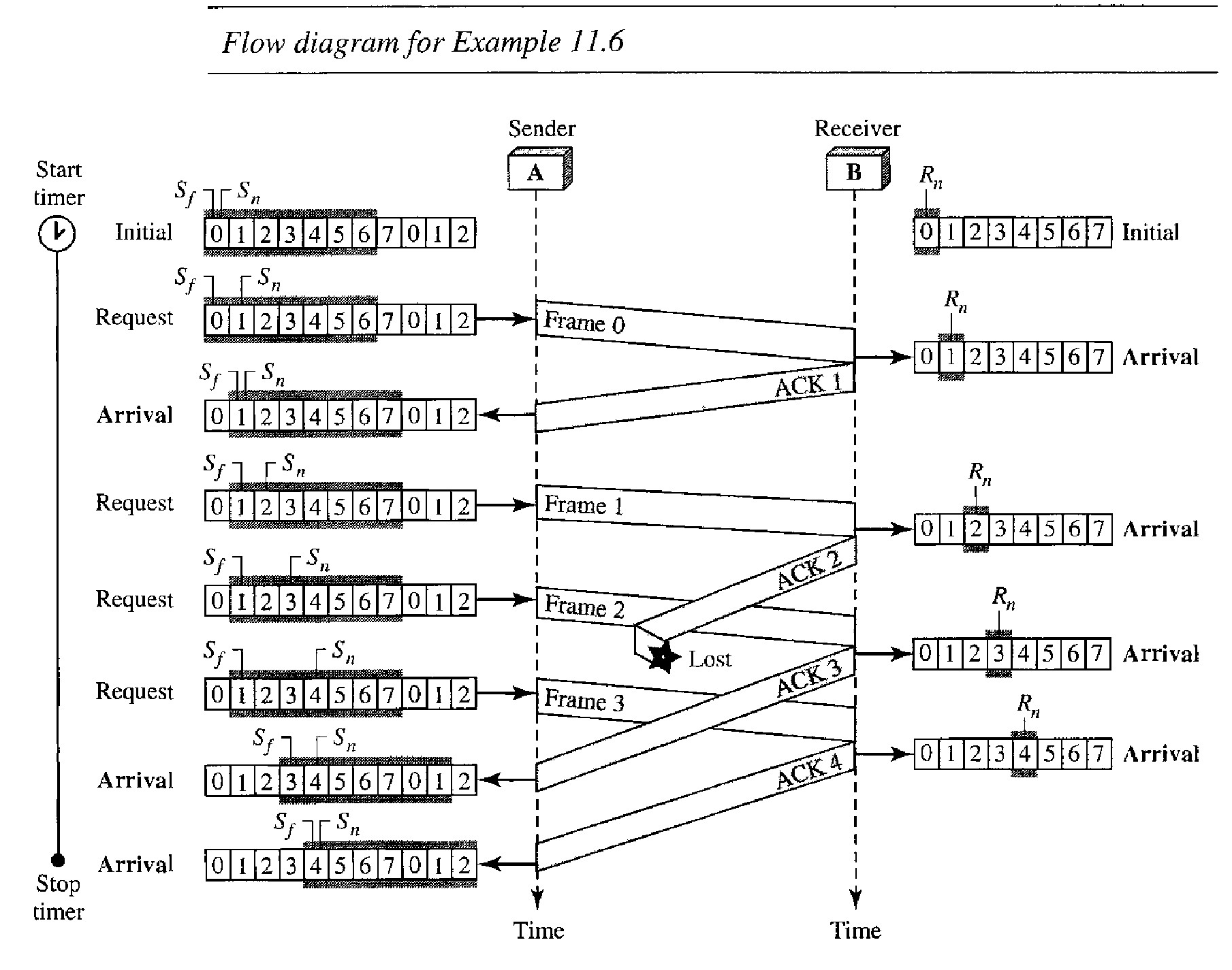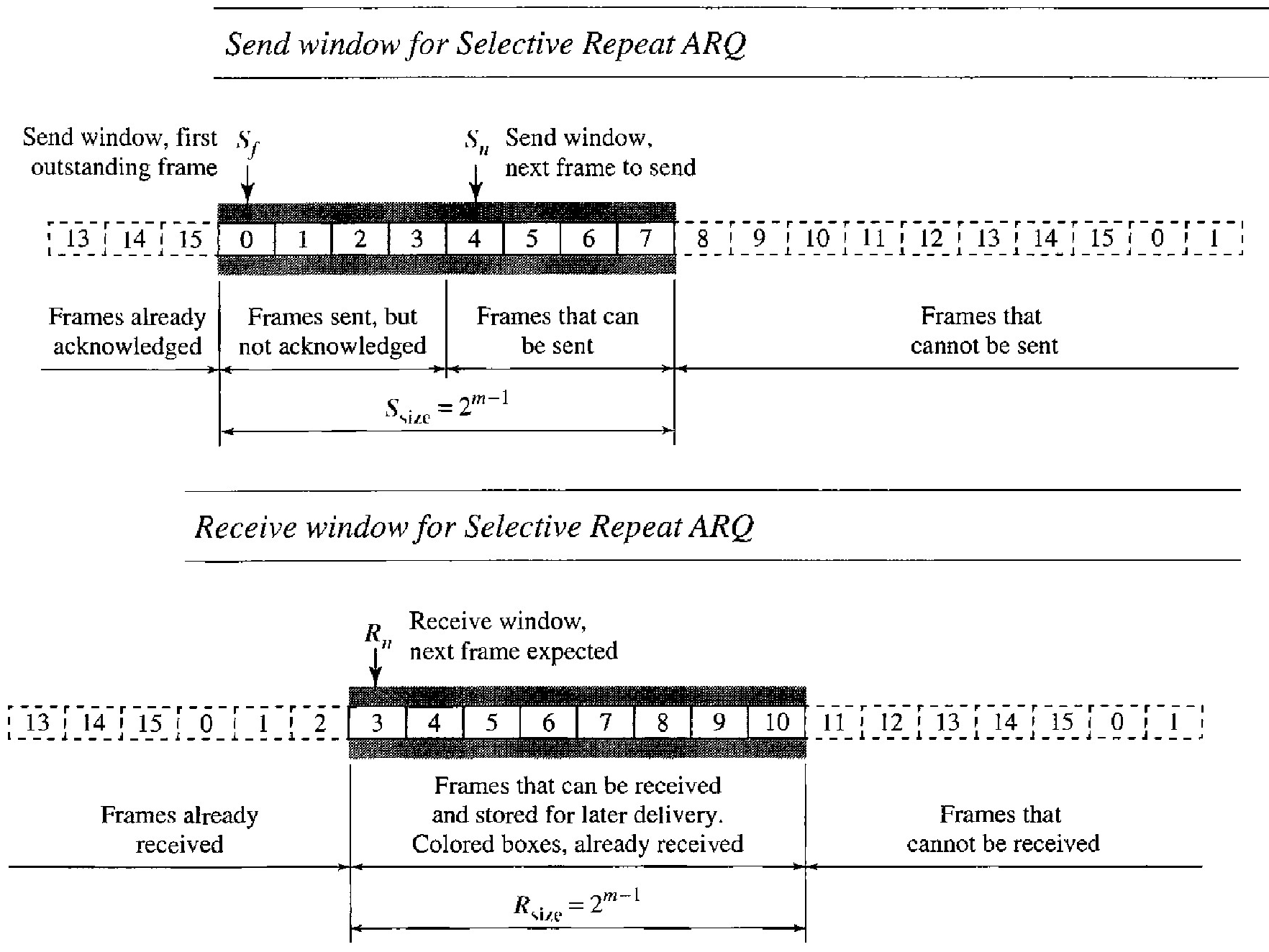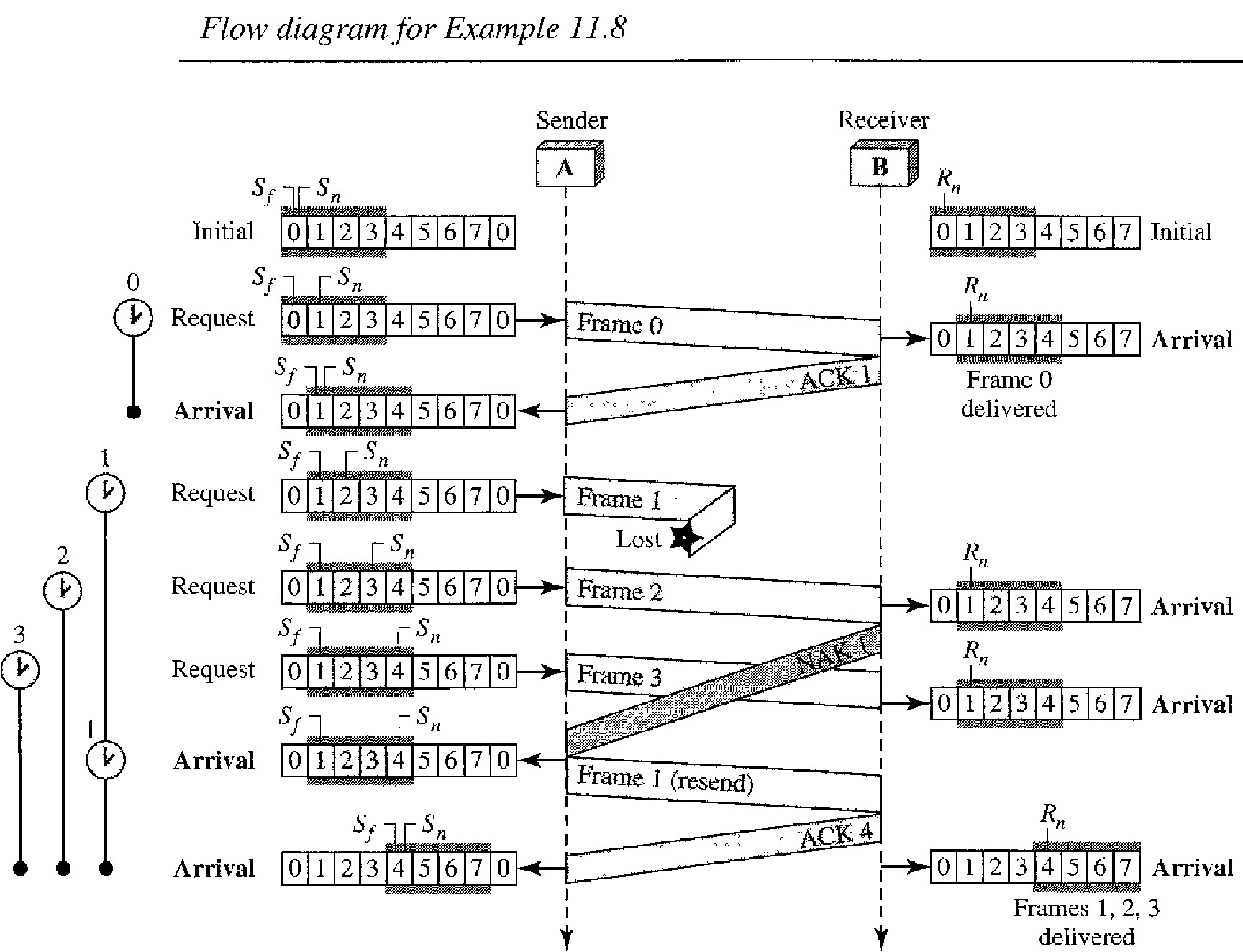Window size for Go-Back-N ARQ
We choose m = 2, which means the size of the window can be 2m - 1, or 3. We can now show why the size of the send window must be less than 2m.
If the size of the window is 3 (less than 22) and all three acknowledgments are lost, the frame 0 timer expires and all three frames are resent.
The receiver is now expecting frame 3, not frame 0, so the duplicate frame is correctly discarded. On the other hand, if the size of the window is 4 (equal to 22) and all acknowledgments are lost, the sender will send a duplicate of frame O.
However, this time the window of the receiver expects to receive frame 0, so it accepts frame 0, not as a duplicate, but as the first frame in the next cycle. This is an error.

Cumulative Acknowledgments for Go-Back-N ARQ
This is an example of a case where the forward channel is reliable, but the reverse is not. No data frames are lost, but some ACKs are delayed and one is lost.
After initialization, there are seven sending events. There is no time-out event here because all outstanding frames are acknowledged before the timer expires. Note that although ACK 2 is lost, ACK 3 serves as both ACK 2 and ACK3.
We can say that the Stop-and-Wait ARQ Protocol is actually a Go-Back-N ARQ in which there are only two sequence numbers and the send window size is 1.
In other words, m = 1, 2m - 1 = 1. In Go-Back-N ARQ, we said that the addition is modulo-2m; in Stop-and-Wait ARQ it is 2, which is the same as 2m when m = 1.
Stop-and-Wait ARQ is a special case of Go-Back-N ARQ in which the size of the send window is 1.

Selective Repeat Automatic Repeat Request
Go-Back-N ARQ simplifies the process at the receiver site. The receiver keeps track of only one variable, and there is no need to buffer out-of-order frames; they are simply discarded. However, this protocol is very inefficient for a noisy link. In a noisy link a frame has a higher probability of damage, which means the resending of multiple frames.
This resending uses up the bandwidth and slows down the transmission. For noisy links, there is another mechanism that does not resend N frames when just one frame is damaged; only the damaged frame is resent.
This mechanism is called Selective Repeat ARQ. It is more efficient for noisy links, but the processing at the receiver is more complex.
Selective Repeat Protocol : Send window and receive window
First, the size of the send window is much smaller; it is 2m-1. Second, the receive window is the same size as the send window.
For example, if m = 4, the sequence numbers go from 0 to 15, but the size of the window is just 8 (it is 15 in the Go-Back-N Protocol).
The smaller window size means less efficiency in filling the pipe, but the fact that there are fewer duplicate frames can compensate for this. The protocol uses the same variables as we discussed for Go-Back-N.
The receive window in Selective Repeat is totally different from the one in GoBack-N. First, the size of the receive window is the same as the size of the send window 2m-1.
The Selective Repeat Protocol allows as many frames as the size of the receive window to arrive out of order and be kept until there is a set of in-order frames to be delivered to the network layer.
Because the sizes of the send window and receive window are the same, all the frames in the send frame can arrive out of order and be stored until they can be delivered. We need, however, to mention that the receiver never delivers packets out of order to the network layer.

Selective Repeat Protocol : Working
Here, each frame sent or resent needs a timer, which means that the timers need to be numbered (0, 1, 2, and 3).
The timer for frame 0 starts at the first request, but stops when the ACK for this frame arrives. The timer for frame 1 starts at the second request, restarts when a NAK arrives, and finally stops when the last ACK arrives.
At the second arrival, frame 2 arrives and is stored and marked (colored slot), but it cannot be delivered because frame 1 is missing. At the next arrival, frame 3 arrives and is marked and stored, but still none of the frames can be delivered because frame 1 is still missing.
Only at the last arrival, when finally a copy of frame 1 arrives, can frames 1, 2, and 3 be delivered to the network layer. There are two conditions for the delivery of frames to the network layer: First, a set of consecutive frames must have arrived. Second, the set starts from the beginning of the window.
Another important point is that a NAK is sent after the second arrival, but not after the third, although both situations look the same. The reason is that the protocol does not want to crowd the network with unnecessary NAKs and unnecessary resent frames.
The second NAK would still be NAKI to inform the sender to resend frame 1 again; this has already been done. The first NAK sent is remembered (using the nakSent variable) and is not sent again until the frame slides. A NAK is sent once for each window position and defines the first slot in the window.
The next point is about the ACKs. Notice that only two ACKs are sent here. The first one acknowledges only the first frame; the second one acknowledges three frames. In Selective Repeat, ACKs are sent when data are delivered to the network layer. If the data belonging to n frames are delivered in one shot, only one ACK is sent for an of them.

Piggybacking
The three protocols we discussed in this section are all unidirectional: data frames flow in only one direction although control information such as ACK and NAK frames can travel in the other direction.
In real life, data frames are normally flowing in both directions: from node A to node B and from node B to node A. This means that the control information also needs to flow in both directions.
A technique called piggybacking is used to improve the efficiency of the bidirectional protocols. When a frame is carrying data from A to B, it can also carry control information about arrived (or lost) frames from B; when a frame is carrying data from B to A, it can also carry control information about the arrived (or lost) frames from A.